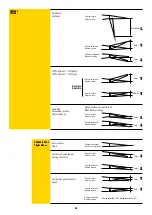
10
AILES/WINGS
9) On commence par l’aileron: insérer l’ensemble
dans le logement servo et raccorder la tringlerie (D)
au guignol intégré dans la gouverne à l’aide de l’axe
(I). Cette étape demande beaucoup de minutie afin de
ne pas abîmer le bord d’attaque de la gouverne. Il faut
l’abaisser fortement et le maintenir avec du ruban
adhésif papier afin d’avoir l’espace nécessaire pour
effectuer cette opération.
H
Start with the aileron: insert the assembly into the
servo housing and connect the linkage (D) to the horn
integrated into the control surface using the spindle
(I). This step requires a lot of care so as not to damage
the leading edge of the control surface. It should be
carefully lowered and held with paper tape to allow
space for this operation.
10) Ensuite, remettre la gouverne au neutre et l’im-
mobiliser avec du ruban adhésif papier.
H
Then center the aileron and secure it with paper
tape.
11) Coller ensuite le cadre de servo (C) dans l’aile à
l’aide de colle époxy lente. Au préalable, vérifier que le
servo est toujours au neutre.
!!!Attention à ne pas marquer la peau de l’aile à l’ex-
trados en collant le servo!!!
H
Then glue the servo frame (C) into the wing with
epoxy glue. Make sure that the servo is always at neu-
tral position.
!!! Be careful not to mark the top skin of the wing by
sticking the servo !!!
Dessus de l’aile
Wing top
I
D
Guignol d’aileron
Aileron horn
Adhésif papier
Paper tape
Goller (C)
Glue (C)
D
12) Insérer la rallonge dans l’aile par le puit du servo
après avoir réalisé l’ouverture pour celle-ci dans la
nervure d’emplanture.
H
Drill a hole as show through root rib.
Then route the
servo extension through the wing from the aileron
servo well to the root.
Découper une ouverture
Drill a hole
Summary of Contents for Finesse Max F3Q
Page 4: ...4 ...






































